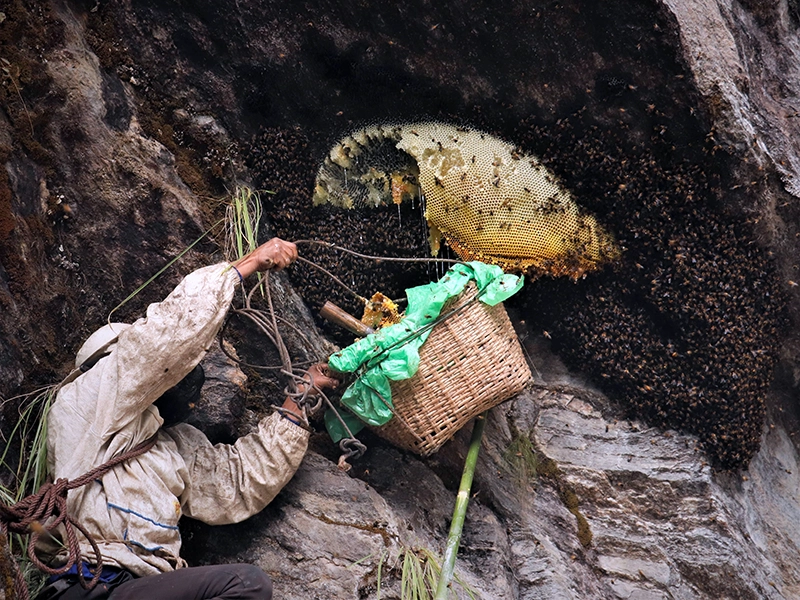The Enigmatic Buzz of the Himalayas: A Guide to Nepal’s “Mad Honey”
7 Jul 2025 Bishal Rijal

For the intrepid traveler seeking the extraordinary, the vertiginous cliffs of Nepal conceal a substance as potent and mythical as the mountains themselves: “Mad Honey.” Far more than a breakfast condiment, this crimson-hued nectar, infused with a powerful natural psychoactive compound, promises a journey into ancient traditions, breathtakingly perilous harvests, and the wild heart of the Himalayas.
For centuries, Nepal’s Gurung people have performed death-defying rituals on sheer rock faces. Armed only with handmade rope ladders and bamboo poles, they scale dizzying heights to reach the crescent-shaped nests of the world’s largest honeybee, Apis dorsata laboriosa. Their coveted prize? Honey transformed by nectar gathered from rhododendron blossoms, rich in potent neurotoxins called grayanotoxins.
This unique nectar imbues the honey with its legendary “madness.” Consumed, it can induce effects ranging from a warm, euphoric glow to vivid hallucinations. Yet mad honey transcends its psychoactive allure. It’s a cornerstone of Gurung culture, a revered traditional medicine, and a magnet for adventurers worldwide.
If your travels are driven by a hunger for the truly unique, the story of Nepal’s mad honey will captivate you. But before you seek out this Himalayan enigma, here’s the essential guide.
The Ancient Art of the Honey Hunt: A Cultural Spectacle
The harvesting of mad honey is a tradition steeped in ritual and respect. It’s a cooperative effort within the Gurung community, undertaken twice a year in the spring and autumn. Before the hunt, elaborate ceremonies are performed to honor the mountain gods and the spirits of the forest, seeking their protection and blessing for the perilous task ahead.

Watching the hunters is witnessing human courage and skill honed over generations. Wisps of smoke pacify the colossal bees. Clinging to swaying ladders hundreds of feet above the valley floor, hunters wield long bamboo poles (tangos) to slice heavy honeycomb sections. These golden prizes are carefully lowered in baskets to villagers below. It’s a breathtaking, visceral spectacle – a rare window into a fragile, ancient way of life.
The Science Behind the “Madness”: Understanding Grayanotoxin

The psychoactive signature of mad honey stems solely from grayanotoxins found in specific rhododendron nectar. These compounds interact with the human nervous system, triggering a cascade of effects.
- Small Doses (e.g., 1 tsp): Often described as a pleasant warmth, tingling relaxation, mild euphoria, and heightened senses. Think a gentle, natural buzz.
- Larger Doses: Risk “mad honey poisoning.” Symptoms escalate: intense dizziness, nausea, vomiting, blurred vision, dangerously slowed heartbeat (bradycardia), and plummeting blood pressure. Crucially, potency varies wildly between hives and seasons. While fatalities are rare, overconsumption guarantees a deeply unpleasant, potentially hazardous experience.
Can Tourists Experience a Honey Hunt?
Yes. Nepal Everest Holidays offer honey hunting expeditions, primarily in regions like Lamjung, Kaski, and the Annapurna foothills. These tours involve trekking to remote Gurung villages.

These experiences often include homestays with local families, allowing for a deep cultural immersion. Tourists can observe the rituals, watch the daring honey hunters in action from a safe distance, and sometimes even sample a small, controlled amount of the freshly harvested honey.
Harvesting Seasons: The prime times to witness a honey hunt are during the spring (April-May) and autumn (October-November).
A Taste of the Wild: Should You Try Mad Honey?

The decision to try mad honey is a personal one and should be approached with caution and respect. For those curious about its effects, it is crucial to do so in a safe and controlled environment, preferably with experienced locals who understand its potency.
Safety Precautions for Tourists:
- Start Small: If you choose to sample mad honey, begin with a very small amount (no more than one teaspoon) and wait at least an hour to gauge its effects before considering more.
- Know Your Source: Purchase honey only from reputable local sources in the villages known for honey hunting. Avoid buying from street vendors in tourist hubs, as the quality and authenticity can be questionable.
- Be Aware of Your Health: Individuals with pre-existing heart conditions, low blood pressure, or who are pregnant should avoid consuming mad honey.
- Never Consume Alone: Try it in the company of others, ideally with a local guide who can assist if you have an adverse reaction.
The Legal Buzz: Buying and Exporting Mad Honey

Mad honey occupies a legal gray area:
- In Nepal: Sale is generally tolerated, especially in shops catering to adventurers in Kathmandu/Pokhara and villages. Explicit national bans are uncommon, but regulations are fluid.
- Exporting/Importing: This is the major hurdle. Most countries strictly prohibit importing food products containing known toxins like grayanotoxins. Customs officials are likely to confiscate it. Research your home country’s specific food import laws meticulously before attempting to bring mad honey back. Assume it’s illegal unless you find explicit confirmation otherwise.
The Final Word: A Unique Himalayan Experience
Mad honey is more than just a psychoactive substance; it’s a window into the rich cultural tapestry and untamed wilderness of Nepal. Whether you’re drawn by the thrill of the hunt, the allure of its effects, or simply the desire for a unique travel story, mad honey offers an unforgettable adventure.
By approaching it with respect for the local culture, an understanding of the risks involved, and a commitment to responsible tourism, you can safely and ethically engage with this fascinating Himalayan tradition. So, for the discerning traveler looking to delve deeper into the magic of Nepal, a taste of mad honey might just be the buzz you’ve been searching for.
